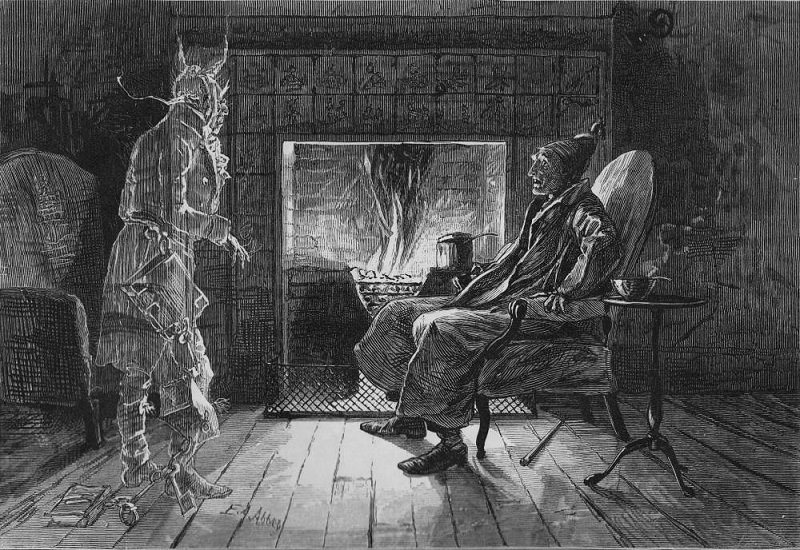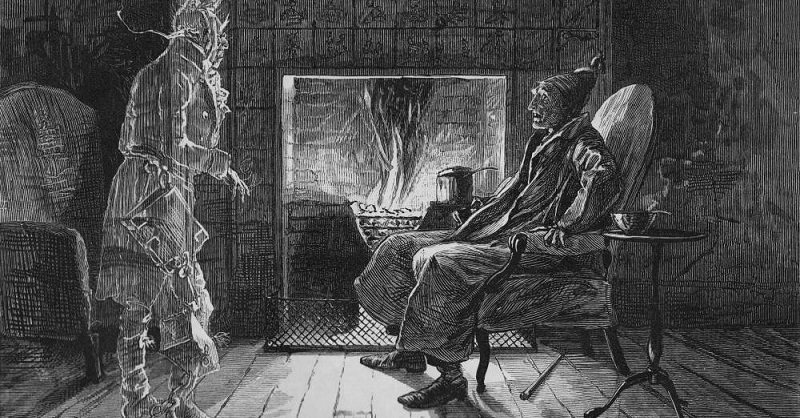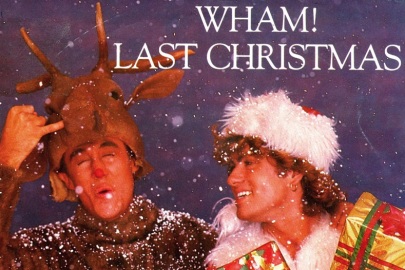
“What do you want with me?” by E. A. Abbey (1876) (Marley’s Ghost visiting Scrooge)
Professor Nick Groom explains the English tradition of the Christmas Eve ghost story…
The nights are long and dark, the wind is bitter chill, the leafless trees are rimed with ice: winter has arrived with a sudden ferocity. What better than to lock the doors, curl up beside a log fire, and read – or better still, listen to – a ghost story?
Most people believe that the Christmas ghost story is a Victorian tradition typified by Charles Dickens. A Christmas Carol is probably the best known of Dickens’s seasonal tales – that evergreen parable of Scrooge, Tiny Tim, and the various comings and goings of the Ghosts of Christmas Past, Present, and Yet to Come. In A Christmas Carol Dickens defuses all the sinister menace of the Gothic and enlists ghosts as prime purveyors of Victorian charity. It was a lucrative move and for the next few years Dickens wrote several supernatural Christmas stories: novels such as The Chimes (1844) and The Haunted Man and the Ghost’s Bargain (1848), as well as short stories such as ‘Christmas Ghosts’ and ‘The Signalman’ (1866).
By the late 1840s, then, Dickens had apparently established a tradition of telling ghost stories at Christmas. A generation later, Jerome K. Jerome introduced Told After Supper (1891), an anthology of Christmas ghost stories, with the observation:
Whenever five or six English-speaking people meet round a fire on Christmas Eve, they start telling each other ghost stories. Nothing satisfies us on Christmas Eve but to hear each other tell authentic anecdotes about spectres. It is a genial, festive season, and we love to muse upon graves, and dead bodies, and murders, and blood.
By that stage, ghost stories had developed from Dickens’s amiable moralizing to suit all tastes, from sensationalist nursery rhymes for children to genuinely disturbing tales of terror. I vividly remember my grandmother, for instance, telling me the shocking tale of a game of hide-and-seek played during a Christmas wedding party in a rambling country house. The newly-wed bride hid inside a heavy chest in an unused room, unfortunately once inside the lock was sprung and she couldn’t get out. And so it was that some years later during a spring clean, the chest was opened and her bones, still of course dressed in her bridal gown, were discovered.
This is a neat example of how popular poetry can enter the oral tradition of family folklore. It’s a legend that appears to derive from ‘Ginevra’, an episode in Samuel Rogers’ 1822 poem Italy. Rogers claimed that he had drawn on tradition for this cautionary tale; he may well have done, but even if not it rapidly caught the public imagination. By 1833 the story was enjoying runaway success as a seasonal lyric, ‘The Mistletoe Bough’, the words of which were written by Thomas Haynes Bayly. The last stanza is sung as follows:
At length an oak chest that had long lain hid,
Was found in the castle – They raised the lid –
And a skeleton form lay mouldering there,
In the bridal wreath of the lady fair!
Oh! sad was her fate! in sportive jest
She hid from her lord in the old oak chest –
It clos’d with a spring! – and her bridal bloom
Lay withering there in a living tomb.
Oh! the misseltoe bough!
I’d like to think that my grandmother heard the song in her childhood and that she remembered the narrative, if not all the words. But perhaps she too may only have heard an outline. On the other hand, maybe she was warning me of something that really had happened in some dark forgotten corner of the English countryside, just around the corner from where she lived.
‘The Mistletoe Bough’ is of course a song highly delighted by its domestic invocation of the Gothic convention of incarceration. Other ghost stories were, however, somewhat less convivial, though equally seasonal. Henry James’s brilliant tour de force The Turn of the Screw (1898) opens on Christmas Eve, enigmatically referring back to a story that has already been told in order to introduce an apparently related theme:
The story had held us, round the fire, sufficiently breathless, but except the obvious remark that it was gruesome, as, on Christmas Eve in an old house, a strange tale should essentially be, I remember no comment uttered till somebody happened to say that it was the only case he had met in which such a visitation had fallen on a child.
What follows is a classic – and ghastly – psychological thriller.
The master of the English ghost story is, however, M. R. James. While Headmaster at Eton he composed ghost stories to be read at Christmas. They remain absolutely terrifying: I readily admit to being unable to read them, even today, without risking nightmares. This is in part due to an old schoolteacher, Mr Dobinson, who would read them to our class in junior school on Friday afternoons at the end of the autumn term. I could not forget them, and brooded over their mysterious and elusive secrets: ‘The Mezzotint’, ‘Lost Hearts’, ‘“Oh, Whistle, and I’ll Come to You, My Lad”’. But when I encountered them again at university I realized their supreme artistry and unbearable uncanniness. Those who have not read them themselves may neverless recall Robert Powell delivering them on the BBC one Christmas week: that was frightening enough for me to rattle those old fears best left in peace.
I am writing as if the Christmas ghost story really is a Dickensian innovation, but clearly the dates of ‘The Mistletoe Bough’ suggest otherwise, and Dickens himself in ‘Christmas Ghosts’ speaks of the old custom of ‘telling Winter Stories – Ghost Stories, or more shame for us – round the Christmas fire’. Indeed, the tradition goes back far further than the Victorians – as one would surely expect. Winter is a season haunted by the ghostly memories of summer and we are approaching the longest night. The history of Christmastide has its dark moments. In 1125 Henry I invited the ‘mint-men’ (those who minted coinage) to Winchester during the Twelve Days of Christmas. Charged with debasing the currency, they had their right hands and their testicles removed. A generation later Thomas Becket was murdered in Canterbury Cathedral on 27 December 1170. Such memories do not die, but find their expression in sinister tales of threat and violence – often supernaturally avenged. Ghost stories – like the Gothic more generally – are fundamentally about the inescapability of the past, about the return of history, about what is supposed to be dead and buried but which is, disastrously, restless and implacable. In The Jew of Malta (c.1590), Christopher Marlowe invokes this old winter tradition as the culture of oral folklore, ignored at one’s peril:
Now I remember those old women’s words,
Who in my wealth would tell me winter’s tales,
And speak of spirits and ghosts that glide by night
About the place that treasure hath been hid.
Likewise, in Shakespeare’s The Winter’s Tale (c.1609-10), the boy Mamillius remarks with a solemnity beyond his years that ‘A sad tale’s best for winter: I have one / Of sprites and goblins…. There was a man – Dwelt by a churchyard…’. Five scenes later he is dead. Even Hamlet (c.1600-1601) has a smack of the winter ghost story about it: it is cold and dark, and much of the action takes place in shadowy castle chambers or in a cemetery overflowing with bones.
Such ‘winter’s tales’ were still being described by John Clare in 1827 in The Shepherd’s Calendar for December (specifically Christmas), in which he describes how
Around the glowing hearth at night,
The harmless laugh and winter tale
Go round, while parting friends delight
To toast each other o’er their ale.
Indeed, by the early eighteenth century, Christmas was the precise time at which to tell these strange tales. Round About Our Coal-Fire, an anonymous pamphlet from about 1730, records celebrations of Christmas in the ‘Sirloins of Beef, the Minc’d-pyes, the Plumb-porridge, the Capons, Turkies, Geese, and Plumb-puddings’ consumed, and in the household amusements enjoyed: dancing, singing, masquerading, and performing little dramas, and in playing games such as blind-man’s buff, puss in the corner (a kissing game), questions and commands (a truth or dare game), hide and hoop (hide and seek), and cards and dice. As the evening wore on members of the family would tell ghost stories – known as the ‘curious memoirs of Old Father Christmas’. More than a century later – and nearly twenty-five years before A Christmas Carol, the American Anglophile Washington Irving recorded the customs of ‘Old Christmas’ in his Sketch Book (1819). Among them was the telling of weird tales:
When I returned to the drawing-room, I found the company seated round the fire, listening to the parson, who was deeply ensconced in a high-backed oaken chair, the work of some cunning artificer of yore, which had been brought from the library for his particular accommodation. From this venerable piece of furniture, with which his shadowy figure and dark weazen face so admirably accorded, he was dealing out strange accounts of popular superstitions and legends of the surrounding country, with which he had become acquainted in the course of his antiquarian researches.
Irving recalls that what particularly excited his companions were the tales of a mediaeval crusader who haunted the area: the effigy on his tomb would rise up that on stormy nights and walk around the churchyard, or his portrait would come to life and, mounted on his charger, ride through walls on mysterious errands.
It is no surprise, then, that the great-grand-daddy of the English Gothic, Horace Walpole’s The Castle of Otranto, was published on Christmas Eve as a seasonal ghost story. In this pioneering supernatural novel, effigies on tombs become monstrous, haunting the fortress and preying on its inmates; portraits stride out of their frames and disappear, never to be seen again; and the dead walk abroad. The Castle of Otranto was first published in 1764; this year is the 250th anniversary of this hallucinatory text. Read it on Christmas Eve, and call on all the Angels of grace to defend you: it is the original nightmare before Christmas.












Fascinating post and Happy Christmas. Other readers may have seen the recent Gothic exhibition at the excellent British Library. The more I think about it, isn’t the ‘Gothic’ very much part of whatever it means to be English? It’s deeply embedded in our culture.
I was especially interested in the history behind the “Mistletoe Bough” legend. My dear old great-aunt used to live next door to the Old Minster Lovell Hall, which claimed to be the manor house in the yarn. But I gather that there are several other houses around England which also claim ownership. I wonder why?
Minster Lovell Hall (what remains of it) is very gothic indeed!
Great stuff – I’ll have to try The Castle of Otranto.
I’ve just written a piece about the legacy of A Christmas Carol for sofa.com here.